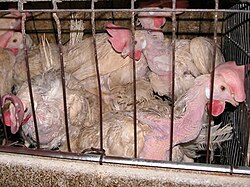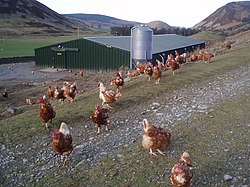
The meat industry are the people and companies engaged in modern industrialized livestock agriculture for the production, packing, preservation and marketing of meat (in contrast to dairy products, wool, etc.). In economics, the meat industry is a fusion of primary (agriculture) and secondary (industry) activity and hard to characterize strictly in terms of either one alone. The greater part of the meat industry is the meat packing industry – the segment that handles the slaughtering, processing, packaging, and distribution of animals such as poultry, cattle, pigs, sheep and other livestock.
Contents
- Global production of meat products
- Companies
- Forecasts
- Sectors involved
- Animal breeding
- Animal production
- Meat packing
- Distribution
- Criticism
- Animal welfare
- Environmental impacts
- Effects on livestock workers
- Industry for alternative meats
- Alternative meat industry
- Cultured meat industry
- See also
- References
- Further reading
A great portion of the ever-growing [1] meat branch in the food industry involves intensive animal farming in which livestock are kept almost entirely indoors [2] or in restricted outdoor settings like pens. Many aspects of the raising of animals for meat have become industrialized, even many practices more associated with smaller family farms, e.g. gourmet foods such as foie gras. [3] [4] This heavy industrialization leads to an outsized environmental impact, responsible for significant greenhouse gas emissions, land use change and degradation, and water, air and soil pollution. [5]
The production of livestock is a heavily vertically integrated industry where the majority of supply chain stages are integrated and owned by one company. [6] Each stage of the process of rearing animals to slaughter, is often concentrated in very few companies -- with some companies dominating multiple stages of the industry; for example in agrochemicals used in animal production 66% of global revenue are concentrated in four firms, in animal pharmaceuticals 58%. [7] For example, Brazil's JBS S.A. have secured market dominance in multiple sectors in the USA and Brazil and is the world's largest animal slaughter company. [5] This large economic influence, both within countries and over international trade, has created significant political influence from the industry. [5] A 2025 review of scholarship found that the animal agriculture industry has played an outsized role in creating obstruction of climate change, by actively supporting disinformation campaigns, and preventing policy to address climate change. [5]















